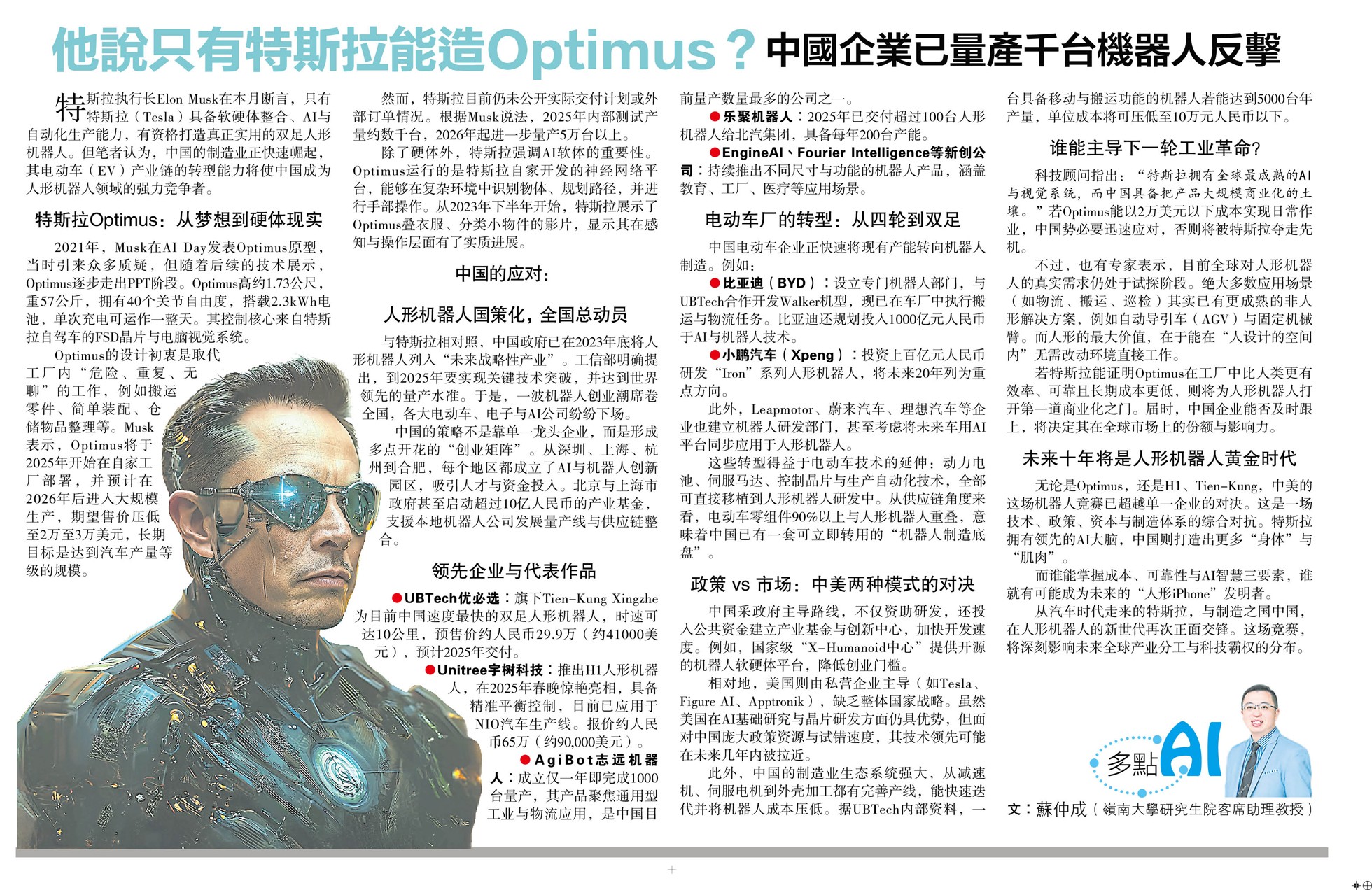🔍 n8n vs Dify.ai & Other LLMOps Platforms
✅ Overview of n8n n8n is a popular open-source workflow automation platform, often compared to

Published on Sin Chew Daily on the 14th May 2025 and HK01
Elon Musk recently declared that only Tesla possesses the capability to mass-produce general-purpose humanoid robots. He emphasized that humanoid robots will be more valuable than electric vehicles (EVs), and that Tesla leads this transformation.
Back in 2021, Musk unveiled Optimus at AI Day 2.0. At the time, many were skeptical, but Tesla has since made progress. Optimus is powered by the same chip used in Tesla’s FSD (Full Self-Driving) computer, consuming just 73 watts. The latest version walks steadily, folds clothes, and uses tools with ease. Musk said Tesla’s goal is to produce more robots than cars in the future, estimating 1,000 units to be manufactured in 2025 and millions in the next decade.
According to him, Optimus will be priced lower than a car and capable of performing repetitive factory tasks. Long-term, these robots will serve homes, perform caregiving duties, and support the elderly. Musk boldly stated: “Only Tesla can build a robot like this.”
Humanoid Robots Go Nationwide
Despite Musk’s statements, China is moving quickly. In 2023, China identified humanoid robots as a “strategic emerging industry,” and in 2025, the Ministry of Industry and Information Technology will launch standards and policies to support development. Local governments across provinces like Shanghai and Anhui are actively supporting humanoid robotics parks and subsidies. Various robotics exhibitions and talent competitions are also being held to foster industrial development.
Chinese EV companies are also entering the humanoid robotics market:
These companies bring with them expertise in motors, energy systems, autonomous driving, and sensors — all core technologies required for humanoid robots. With strong supply chains and manufacturing capacity, their goal is to lead the humanoid robot revolution.
In the US, humanoid robot projects are largely market-driven. Top players like Tesla, Figure AI, and Apptronik rely on venture capital. In contrast, China combines both policy and market, accelerating progress by mobilizing national and local support.
Though the US excels in foundational AI models and software, China’s edge lies in scale, supply chain readiness, and engineering talent. China can iterate hardware products at speed and cost-efficiency unmatched by Silicon Valley startups.
In terms of market size, it’s predicted that the humanoid robot market will reach 10 million units per year by 2035, with a value of 1 trillion RMB. Labor shortages in aging societies are driving demand, with estimates that a single robot can replace multiple human workers.
This is why Musk believes the future lies with Optimus. However, China’s current pace of development and production shows that it has already seized a competitive edge. Industry experts predict that by 2030, the world’s largest humanoid robot production will be in China.
Whether it’s Optimus or other brands, the next ten years will be the golden era of humanoid robotics.
According to Tian-Kung Xinghe, Walker S can perform home and caregiving tasks, such as guiding people or taking care of the elderly. In the future, the integration of general-purpose AI into humanoid robots will bring about fundamental changes to society, business operations, and even our daily lives.
Robots like these will not just be tools, but collaborative assistants with real interaction capabilities. In this historic moment of AI and robotics convergence, a new industrial revolution is quietly taking shape.
以下是從圖片中提取的完整中文文章內容:
特斯拉執行長 Elon Musk 在本月聲稱,只有特斯拉(Tesla)具有大規模製造具備人形能力的機器人,他強調特斯拉的Optimus人形機器人,性能越來越外界驚艷,並表示其對公司的重要性將超越電動車(EV),甚至將來所有公司都會使用像 Optimus 這樣的機器人。
2021年,Musk 在 AI Day 發表 Optimus 機型,當時引來眾多質疑。但隨著近年的技術展示,Optimus逐步步出 PPT 範疇,Optimus的功耗僅73瓦,耗電不到吹風機的一半。Optimus最新版本已能雙足行走、搬運物品、疊衣服、使用工具等動作,預計2025年開始大量生產,價格比汽車更便宜。
他預言,未來工廠內的重複性工作會交由機器人完成,甚至會進入家庭,照顧長者、陪伴小孩。他強調 Optimus 會比電動車更賺錢,2025年起每年將生產千台,未來10年生產百萬台。他更自信地說:「全世界只有特斯拉可以造出像 Optimus 這樣的機器人。」
根據材料科學網報導,中國在 2023 年將人形機器人列為“未來產業”,計畫在 2025 年發佈標準,工信部將提出人形機器人的產業政策和發展目標。同時地方政府也積極響應,如上海、安徽等地都在籌建人形機器人產業園,並舉辦各種機器人大賽和人才競賽。
🔺UBTech 優必選:旗下 Tien-Kung Xinghe 為目前中國最成熟人形機器人,Walker S 售價人民幣 269 萬(約410萬港元),計畫 2025 年交付。
🔺Unitree 宇樹科技:推出 H1 人形機器人,NIO ET5 大小身型,可奔跑、跳躍、雙足行走,H1 EVO版本更已優化。售價人民幣16萬元(約港幣19萬),目前已量產100 台以上。
🔺傅利葉智能、鷹峰智能 EngineAI 等新創公司也推出不同尺寸與功能的人形產品,涵蓋從康復、搬運、陪伴等應用。
中國自動車企業也開始跨界投入智能化的機器人開發:
🔺比亞迪(BYD):設立專門機器人團隊,與 UBTech 合作開發 Walker 模型,現已在平湖市啟動百畝智能工廠,投資超過10億人民幣。
🔺小鵬汽車(Xpeng):投入百億元人民幣開發 “Iron” 第四代人形機器人,將於 2024 年與市場見面。
🔺華為、理想汽車、蔚來汽車、理想汽車等多家車企 也都啟動人形機器人相關項目,未來將把智能駕駛與人形機器人融合。
這些企業擁有電機、動力電池、感測器、AI 駕駛演算法等核心技術,具備大規模量產與供應鏈能力,成為人形機器人發展的重要參與者。
中美的競爭已全面展開,不僅在大模型,在機器人領域也形成兩種不同模式:美國多由市場驅動,依靠 Tesla、Figure AI、Apptronik 等新創企業透過風險資本投資。中國則由政策與市場雙驅動,中央和地方政策強力支持產業規模化發展,企業動作更迅速。
雖然美國在AI底層模型與控制系統具有優勢,但中國工程人才數量、硬體整合能力、供應鏈與製造速度已經逐步追上,甚至有望超車。中國的人形機器人可迭代速度快、造價低、維修便捷,已開始向外出口。
目前有多家投行預測,未來全球人形機器人年銷量將超過千萬台,市場規模超過10萬億人民幣。若每台可取代多名勞工與操作功能的機器人能達到5000台年產能,其年產值將逼近10萬人民幣以上。
目前看來,誰能實現大規模量產、誰能率先建立產業鏈、誰能快速普及,誰就能主導下一輪工業革命。Optimus 是代表之一,但中國企業已大舉進場,未來全球最大的人形機器人生產基地,很可能出現在中國。
無論是 Optimus、還是 Tien-Kung,一生的夢想都是製造一個像人一樣的機器人,並讓它幫助我們完成工作、照顧家人、減輕負擔、甚至成為我們的朋友。
現在,這也許不再是夢想。隨著生成式 AI 技術加持、電池與感測器成本降低、AI 訓練能力突破,機器人產業將迎來新一輪革命。未來,我們每一間公司、每一個家庭,或許都會擁有一個屬於自己的「Optimus」。
✅ Overview of n8n n8n is a popular open-source workflow automation platform, often compared to
Overview: Low-code LLMOps platforms allow developers and non-experts to build, deploy, and manage AI applications
Published on Sin Chew Daily on the 14th May 2025 and HK01 Elon Musk recently